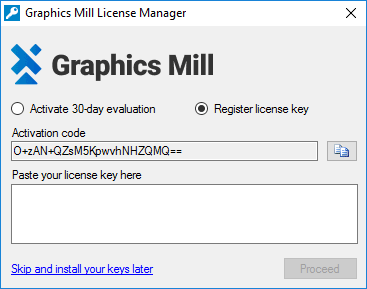Machine Key Generator Net 4
May 20, 2015 How To Generate Machine Key In IIS Complete steps is described in this video regarding How To Generate Machine Key In IIS If you got any clarification on this, please write it on Comment section. Version 4 UUID Generator Generate a version 4 UUID. Bulk Version 4 UUID Generation. Download to a file. What is a version 4 UUID? A Version 4 UUID is a universally unique identifier that is generated using random numbers. The Version 4 UUIDs produced by this site were generated using a secure random number generator.
- Jan 12, 2011 This article describes how to create keys to use for encryption, decryption, and validation of Forms authentication cookie data. You can use the keys that you create in this article for the validationKey and decryptionKey attributes of the section in the element in the web.config file or Machine.config. The following list outlines the.
- Apr 17, 2017 Hi mgebhard, Thanks for your response. I understand the machineKey tag itself and its attributes. My question is lets say I have decided to use the 64bit (256bit - SHA256) key.
- ASP.NET machineKey Generator This is an application that will generate a valid machineKey block with random, secure, hard-coded keys that you can paste inside the in your web.config or machine.config file.
- Jul 31, 2012 If the MachineKey isn't configured in the web.config, where does the default value get pulled from? I checked the Machine.config for ASP.NET 4.0 and it wasn't there. My team wants to set this value at a higher level than the web.config in case one of our developers forgets to add the machine key to the web.config.
The machineKey element of the ASP.NET web.config specifies the algorithm and keys that ASP.NET will use for encryption. By default the validationKey and the decryptionKey keys are set to AutoGenerate which means the runtime will generate a random key for use. This works fine for applications that are deployed on a single server. When you use webfarms a client request can land on any one of the servers in the webfarm. Hence you will have to hardcode the validationKey and the decryptionKey on all your servers in the farm with a manually generated key.
There are a lot of articles that describe how to use RNGCryptoServiceProvider to generate a random key. There are also a lot of online tools that generate random keys for you. But I would suggest writing your own script because any one who has access to these keys can do evil things like tamper your forms authentication cookie or viewstate.
With IIS 7 you no longer have to do this manually. Final draft for mac. The IIS 7.0 manager has a built in feature that you can use to generate these keys.
It uses RNGCryptoServiceProvider internally to create a random key. The value is stored locally in the web.config of that application something like

<?xml version='1.0' encoding='UTF-8'?>
<configuration>
<system.web>
<machineKey decryptionKey='F6722806843145965513817CEBDECBB1F94808E4A6C0B2F2,IsolateApps' validationKey='C551753B0325187D1759B4FB055B44F7C5077B016C02AF674E8DE69351B69FEFD045A267308AA2DAB81B69919402D7886A6E986473EEEC9556A9003357F5ED45,IsolateApps' />
</system.web>
</configuration>
Key Generator Download
You can copy it and paste it in the web.config file of all the servers in the webfarm.
-->Serial Key Generator
The implementation of the <machineKey> element in ASP.NET is replaceable. This allows most calls to ASP.NET cryptographic routines to be routed through a replacement data protection mechanism, including the new data protection system.
Package installation
Note

The new data protection system can only be installed into an existing ASP.NET application targeting .NET 4.5.1 or later. Installation will fail if the application targets .NET 4.5 or lower.
To install the new data protection system into an existing ASP.NET 4.5.1+ project, install the package Microsoft.AspNetCore.DataProtection.SystemWeb. This will instantiate the data protection system using the default configuration settings.
When you install the package, it inserts a line into Web.config that tells ASP.NET to use it for most cryptographic operations, including forms authentication, view state, and calls to MachineKey.Protect. The line that's inserted reads as follows.
Tip
You can tell if the new data protection system is active by inspecting fields like __VIEWSTATE, which should begin with 'CfDJ8' as in the example below. 'CfDJ8' is the base64 representation of the magic '09 F0 C9 F0' header that identifies a payload protected by the data protection system.
Package configuration
The data protection system is instantiated with a default zero-setup configuration. However, since by default keys are persisted to the local file system, this won't work for applications which are deployed in a farm. To resolve this, you can provide configuration by creating a type which subclasses DataProtectionStartup and overrides its ConfigureServices method.
Below is an example of a custom data protection startup type which configured both where keys are persisted and how they're encrypted at rest. It also overrides the default app isolation policy by providing its own application name.
Tip
You can also use <machineKey applicationName='my-app' .. /> in place of an explicit call to SetApplicationName. This is a convenience mechanism to avoid forcing the developer to create a DataProtectionStartup-derived type if all they wanted to configure was setting the application name.
To enable this custom configuration, go back to Web.config and look for the <appSettings> element that the package install added to the config file. It will look like the following markup:
Fill in the blank value with the assembly-qualified name of the DataProtectionStartup-derived type you just created. If the name of the application is DataProtectionDemo, this would look like the below.
Generate Machine Key
The newly-configured data protection system is now ready for use inside the application.